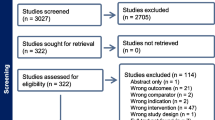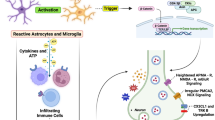Abstract
Purpose
Clinically, neuropathic pain is frequent and intense following brachial plexus injury. It is thought that brachial plexus pain is not generated by avulsed roots, but rather by non-avulsed roots, since the avulsed root could not possibly transmit action potentials to central nerves. The aim of this study was to evaluate pain behavior and activation of sensory neurons in a brachial plexus avulsion (BPA) model in rats.
Methods
Fifteen male Wistar rats were used. In the BPA group, the C8–T1 roots were avulsed from the spinal cord with forceps at the lower trunk level (n = 5). In the naïve group, rats did not receive any procedures (n = 5). In the sham-operated group, the lower trunk was simply exposed (n = 5). Mechanical hyperalgesia of forelimbs corresponding to C6 and C7 dermatomes was measured using von Frey filaments every third day for 3 weeks. Activation of DRG neurons was immunohistochemically examined using anti-ATF3 (a marker for neuron activation) antibodies 21 days after surgery. Von Frey and immunohistochemical data between groups were analyzed using a Kruskal–Wallis test, followed by Mann–Whitney U tests. Bonferroni corrections were performed.
Results
Animals in the BPA group displayed significant mechanical hyperalgesia at the dermatome innervated by uninjured nerves continuing through day 21 compared with animals in the sham-operated group. ATF3-immunoreactive small and large DRG neurons were significantly activated in the BPA group (10.6 ± 9.5 and 5.2 ± 4.1 %, 39.7 ± 6.7 and 25.2 ± 10.3 %, 78.0 ± 9.1 and 53.7 ± 29.3 %) compared with the sham-operated group (0.7 ± 0.9 and 0 ± 0 %, 2.8 ± 2.0 and 1.0 ± 2.0 %, 3.9 ± 2.7 and 8.6 ± 10.1 %) at every level of C5, 6, and 7. In the naïve group, no DRG neurons were activated. ATF3-immunoreactive small and large DRG neurons were significantly activated at the level of C7 compared with C6 and C5, and significantly activated at the level of C6 compared with C5 in the BPA group.
Conclusions
Expression of ATF3 in uninjured DRG neurons may contribute to pain following brachial plexus avulsion injury. Consequently, spared spinal sensory nerves may represent therapeutic targets for treatment of this pain.



Similar content being viewed by others
References
Anand P, Birch R (2002) Restoration of sensory function and lack of long-term chronic pain syndromes after brachial plexus injury in human. Brain 125:113–122
Berman JS, Birch R, Anand P (1998) Pain following human brachial plexus injury with spinal cord root avulsion and the effect of surgery. Pain 75:199–207
Carvalho GA, Nikkhah G, Samii M (1997) Pain management after post-traumatic brachial plexus lesions. Conservative and surgical therapy possibilities. Orthopede 26:621–625
Parry CB (1980) Pain in avulsion lesions of the brachial plexus. Pain 9:41–53
Parry CB (1984) Brachial plexus injuries. Br J Hosp Med 32:130–139
Alnot JY (1995) Traumatic brachial plexus lesions in the adult. Indications and results. Hand Clin 4:623–631
Berman J, Anand P, Chen L, Taggart M, Birch R (1996) Pain relief from preganglionic injury to the brachial plexus by late intercostal nerve transfer. J Bone Jt Surg 78:759–760
Bertelli JA, Ghizoni MF (2008) Pain after avulsion injuries and complete palsy of the brachial plexus: the possible role of nonavulsed roots in pain generation. Neurosurgery 62:1104–1114
Rodrigues-Filho R, Santos AR, Bertelli JA, Calixto JB (2003) Avulsion injury of the rat brachial plexus triggers hyperalgesia and allodynia in the hindpaws: a new model for the study of neuropathic pain. Brain Res 982:186–194
Paszcuk AF, Dutra RC, da Silva KA, Quintão NL, Campos MM, Calixto JB (2011) Cannabinoid agonists inhibit neuropathic pain induced by BPA in mice by affecting glial cells and MAP kinases. PLoS One 6:e24034
Takahashi Y, Nakajima Y (1996) Dermatomes in the rat limbs as determined bv antidromic stimulation of sensory C-fibers in spinal nerves. Pain 67:197–202
Chaplan SR, Bach FW, Pogrel JW, Chung JM, Yaksh TL (1994) Quantitative assessment of tactile allodynia in the rat paw. J Neurosci Methods 53:55–63
Novakovic SD, Tzoumaka E, McGivern JG, Haraguchi M, Sangameswaran L, Gogas KR et al (1998) Distribution of the tetrodotoxin-resistant sodium channel PN3 in rat sensory neurons in normal and neuropathic conditions. J Neurosci 18:2174–2187
Harper AA, Lawson SN (1985) Conduction velocity is related to morphogical cell type in rat dorsal root ganglion neurones. J Physiol 359:31–46
Ciaramitaro P, Mondelli M, Logullo F, Grimaldi S, Battiston B, Sard A et al (2010) Traumatic peripheral nerve injuries: epidemiological findings, neuropathic pain and quality of life in 158 patients. J Peripher Nerv Syst 15:120–127
Ramer LM, Borisoff JF, Ramer MS (2004) Rho-Kinase Inhibition Enhances Axonal Plasticity and Attenuates Cold Hyperalgesia after Dorsal Rhizotomy. J Neurosci 24:10796–10805
Chang YW, Winkelstein BA (2011) Schwann cell proliferation and macrophage infiltration are evident at day 14 after painful cervical nerve root compression in the rat. J Neurotrauma 28:2429–2438
Bennett GJ, Xie YK (1988) A peripheral mononeuropathy in rat that produces disorders of pain sensation like those seen in man. Pain 33:87–107
Yi H, Kim MA, Back SK, Eun JS, Na HS (1990) A novel behavioral model of neuropathic pain disorders produced in rats by partial sciatic nerve injury. Pain 43:205–218
Kim SH, Chung JM (1992) An experimental model for peripheral neuropathy produced by segmental spinal nerve ligation in the rat. Pain 50:355–363
Li Y, Dorsi MJ, Meyer RA, Belzberg AJ (2000) Mechanical hyperalgesia after an L5 spinal nerve lesion in the rat is not dependent on input from injured nerve fibers. Pain 85:493–502
Lindwall C, Kanje M (2005) The Janus role of c-Jun: cell death versus survival and regeneration of neonatal sympathetic and sensory neurons. Exp Neurol 196:184–194
Seijffers R, Allchorne AJ, Woolf CJ (2006) The transcription factor ATF-3 promotes neurite outgrowth. Mol Cell Neurosci 32:143–154
Woolf CJ, Shortland P, Coggeshall RE (1992) Peripheral nerve injury triggers central sprouting of myelinated afferents. Nature 355(2):75–78
Fukuoka T, Tokunaga A, Kondo E, Miki K, Tachibana T, Noguchi K (1998) Change in mRNAs for neuropeptides and the GABA(A) receptor in dorsal root ganglion neurons in a rat experimental neuropathic pain model. Pain 78:13–26
Koltzenburg M, Lundberg LE, Torebjörk HE (1992) Dynamic and static components of mechanical hyperalgesia in human hairy skin. Pain 51:207–219
Vrinten DH, Kalkman CJ, Adan RA, Gispen WH (2001) Neuropathic pain: a possible role for the melanocortin system? Eur J Pharmacol 429:61–69
Lekan HA, Carlton SM, Coggeshall RE (1996) Sprouting of Ab fibers into laminae II of the rat dorsal horn in peripheral neuropathy. Neurosci Lett 208:147–150
Nakamura S, Myers RR (1999) Myelinated afferents sprout into laminae II of L3–5 dorsal horn following chronic constriction nerve injury in rats. Brain Res 818:285–290
Shortland P, Kinman E, Molander C (1997) Sprouting of A-fiber primary afferents into laminae II in two rat models of neuropathic pain. Eur J Pain 1:215–227
Malmberg AB, Basbaum AI (1998) Partial sciatic nerve injury in the mouse as a model of neuropathic pain: behavioral and neuroanatomical correlates. Pain 76:215–222
Treede RD, Meyer RA, Raja SN, Campbell JN (1992) Peripheral and central mechanisms of cutaneous hyperalgesia. Prog Neurobiol 38:397–421
Hatashita S, Sekiguchi M, Kobayashi H, Konno S, Kikuchi S (2008) Contralateral neuropathic pain and neuropathology in dorsal root ganglion and spinal cord following hemilateral nerve injury in rats. Spine 33:1344–1351
Conflict of interest
None.
Author information
Authors and Affiliations
Corresponding author
Rights and permissions
About this article
Cite this article
Matsuura, Y., Ohtori, S., Iwakura, N. et al. Expression of activating transcription factor 3 (ATF3) in uninjured dorsal root ganglion neurons in a lower trunk avulsion pain model in rats. Eur Spine J 22, 1794–1799 (2013). https://doi.org/10.1007/s00586-013-2733-5
Received:
Revised:
Accepted:
Published:
Issue Date:
DOI: https://doi.org/10.1007/s00586-013-2733-5




